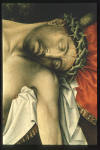

"Deposition
was the center panel of a triptych the Archer's guild of Louvain
commissioned for the church of Notre Dame hors-le-murs in
Louvain. Rogier acknowledged the patrons of this large
painting by incorporating the cross-bow (the guild's symbol)
into the decorative spandrels in the corners."
- Gardner's
Art Through The Ages,
11th edition, Vol. II, p. 571

"This
altarpiece nicely sums up Rogier's early style and content.
Instead of creating a deep landscape setting, as
Jan van Eyck might
have, he compressed figures and action onto a shallow stage to
concentrate the observer's attention. Here, Rogier
imitated the large sculptured shrines so popular in the
fifteenth century, especially in Germany, and the device
admirably serves his purpose of expressing maximum action within
a limited space. The painting, with the artist's crisp
drawing and precise modelling of form, resembles a stratified
relief carving. A series of lateral undulating movements
gives the group a unity, a formal cohesion that Rogier
strengthened by psychological means - by the desolating anguish
common to all the figures. The similar poses of Christ and
the Virgin Mary further unify Deposition. Few painters
have equalled Rogier in the rendering of passionate sorrow as it
vibrates through a figure or distorts a tear-stained face.
His depiction of the agony of loss is among the most authentic
in religious art. The emotional impact on viewers is
immediate and direct."
- Gardner's
Art Through The Ages,
11th edition, Vol. II, p. 571
|